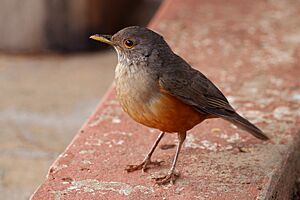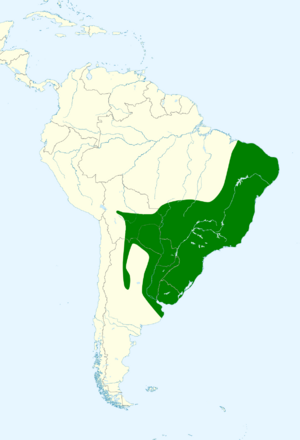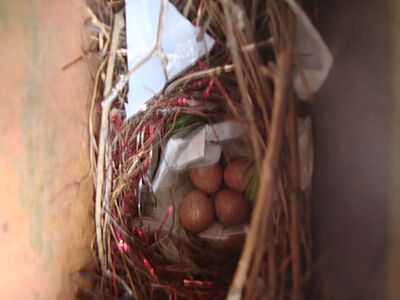Rufous-bellied thrush facts for kids
Quick facts for kids Rufous-bellied thrush |
|
|---|---|
 |
|
| Adult bird in the Pantanal, Brazil | |
| Conservation status | |
| Scientific classification | |
| Genus: |
Turdus
|
| Species: |
rufiventris
|
 |
|
The rufous-bellied thrush (scientific name: Turdus rufiventris) is a lovely songbird. It belongs to the thrush family. You can find this bird in many parts of eastern and southeastern Brazil. It also lives in Bolivia, Paraguay, Uruguay, and central Argentina.
This thrush is very common in southeastern Brazil. People there call it sabiá-laranjeira. It is a very special bird in Brazil. It was even mentioned in a famous Brazilian poem called Canção do exílio. The rufous-bellied thrush has been the state bird of São Paulo since 1966. It became the national bird of Brazil in 2002. Its beautiful song is often heard in the afternoons. Sometimes, thousands of them sing all night long, from August to November. Many people in Brazil see this bird as a symbol of their country.
Contents
What Does It Look Like?
This bird gets its name from its bright reddish-orange belly. The rest of its body is mostly brown. Rufous-bellied thrushes can grow up to 25 centimeters (about 10 inches) long. They usually weigh around 59 to 64 grams (about 2 ounces). Female birds are often a bit heavier than males.
Where Does It Live and What Does It Eat?
You can find the rufous-bellied thrush in forests. They also live in parks and gardens in cities. This bird is an omnivorous animal. This means it eats both plants and animals. Its main foods are fruits and small bugs like arthropods.
Sometimes, you might see them with other birds. They move through bushes together, looking for food. They have even been seen looking for food near army ants. This is especially true during the dry season when fruits are harder to find.
How Does It Reproduce?
The rufous-bellied thrush builds a cup-shaped nest. They can build their nests in many places. Some nests are right on the ground. Others are high up in trees, more than 20 meters (65 feet) high. But most nests are about 4 to 5 meters (13-16 feet) above the ground.
In some areas, like the yungas of Argentina, they nest from October to March. Most birds breed in November and December. The female usually lays two or three eggs. Each egg is about 27-28 by 20 millimeters and weighs around 5.7 to 5.9 grams.
The mother bird sits on the eggs to keep them warm. This is called incubation. It takes about 12 to 13 days for the eggs to hatch. After the chicks hatch, they stay in the nest for about the same amount of time. Both parents help feed the young birds. As the chicks get ready to leave the nest, they are fed very often.
Is It Endangered?
The rufous-bellied thrush is a very common bird. It lives in many different places. Because of this, it is not considered to be in danger of extinction. The IUCN (International Union for Conservation of Nature) says it is a species of "least concern."
Images for kids
-
Bird's nest in a mailbox, located in a residence of the Northern Zone of São Paulo, Brazil; note the use of plastic bags, twigs, and feathers in its construction
-
Note rufous belly. Costanera Sur Ecological Reserve, Argentina




